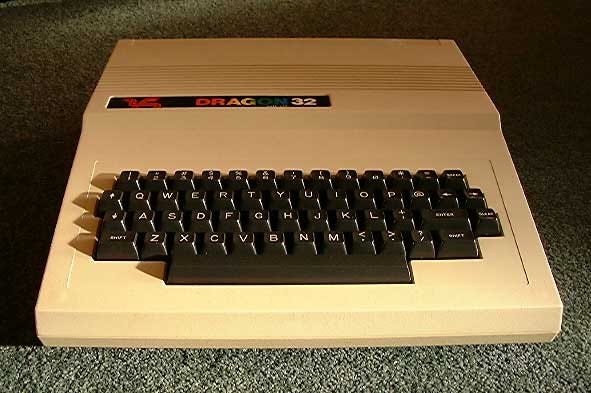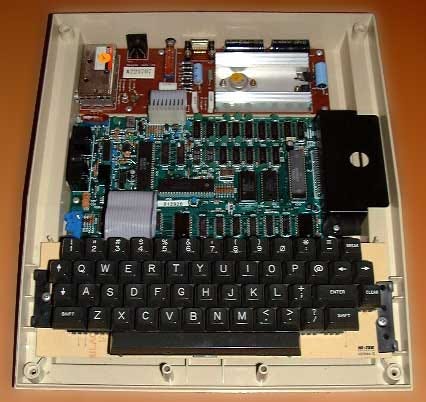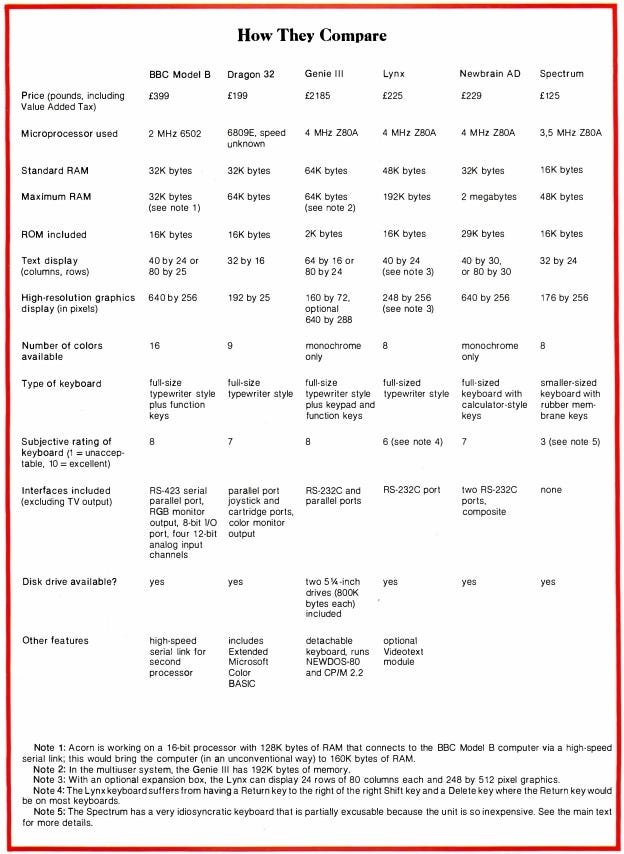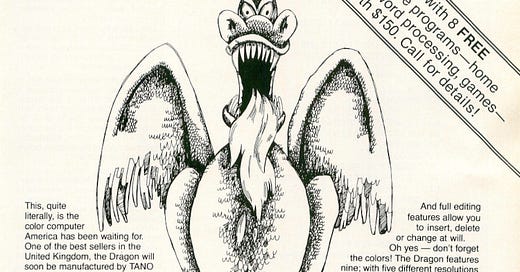The Company
Dragon Data Ltd was created by the British toy company Mettoy in 1982. The Welsh company released their first computer in August of that year. The Dragon 32 stood out from other products on the UK personal computer scene because it used the Motorola MC6809E processor instead of the more popular Zilog Z80 and Mostek chips.
According to an article written by David Linsley entitled “A Slayed Beast”, Dragon designers were in close contact with the people at Motorola. The resulting product used the same chipset at the Tandy Color Computer. Linsley says, “The machine of questionable copyright even used the same keyboard layout, cartridge connector, joystick ports (Tandy 5-pin could be used, but not 6-pin due to the Dragon's use of 5-pin DIN sockets), and memory map. You could also say that the tape connector was the same but as this was a standard, its hardly worth mentioning.”

They also decided that the system would come with an extended version of Microsoft’s BASIC. This was done, so that customers would not have to upgrade to use all the BASIC features that they wanted to. Most other systems of the time, such as the Texas Instrument TI-99/4A, same with a more limited version of BASIC in the ROM.
Obviously, there was the possibility that Tandy could come after them for using a similar designed. Again, Linsley tells us what steps Dragon took to avoid this:
To solve possible legal action from Tandy, the Dragon engineers came up with a work-around solution. A parallel printer socket would be included instead of the serial device on their counterparts machine; this was a better solution for the end-user wishing to connect a printer because no setting up is needed - plug in and go - no messy dip switches to set baud rate and parity etc. So that the electronics would be simpler, the printer data lines would use the same Motorola MC6821 PIA port as the keyboard - this allowed the keyboard to be remapped also, so that it looked the same as a Tandy, but operated differently (e.g. Dragon Q is Tandy 1). Most importantly though the Basic ROM had the keyword 'tokens' reworked and re-assembled so that both the Basic and Extended Basic parts were mixed, and as Tandy's were separate the routines addresses would be at different locations. Part of this re-assembly included a partially re-written BIOS (the original belonged to Tandy) - witness the letters DNS appearing for no-reason, as these are the authors initials; Duncan Smeed who before joining Dragon lectured in computing at Strathcylde University (where he has since returned).
At the time, computer stores were not as prevalent as they would be in a few years. So, Mettoy convinced Boots, a British pharmacy chain that also sold Mettoy electronics, to carry Dragon computers.
Initial demand was unexpectedly high. This was due to the fact that both Acorn and Sinclair computers were only available via mail order and rarely in shops.
However, things were not looking good for Dragon. In October, their mother company’s finances were in bad shape. After several failed attempts to refinance, Mettoy was able to persuade several institutions to invest in Dragon. By the Spring of 1983, Dragon Data became the largest privately owned company in Wales and had sold 40,000 systems.
By now, you are probably wondering when Tano is going to enter this story. After all, their name is in the title of this article. Well, in April of 1983 Dragon announced that they were in talks with three US companies to sell the Dragon in the US and the surrounding region. A couple of months later, they announced that Tano Corporation of New Orleans has been selected. According to Linsley, Tano was picked because “due to its background in marine automation systems with the 6809 microprocessor and that it already had experience of selling a micro - an Apple II clone designed in Holland and manufactured in Korea.”
On August 26th, 1983, the Dragon 64 was launched. To be honest, there weren’t many differences between the 32 and 64. The Dragon 64 had two versions of BASIC: a modified version of Dragon 32 BASIC (which was limited to 24Kb of RAM) and a Dragon 64 BASIC that could use all 64 Kb of RAM. Besides that, the Dragon 64 had an RS-232 serial port connection.
The Dragon 64 was released in Britain two months later. By this time, competition had increased as several US PC brands were now available. On top of that, there was an issue when it came to upgrading the systems. Originally, it was announced that customers could get a board to upgrade your Dragon 32 to be a Dragon 64, but it did not include the serial port. However, that was scrapped, and a new simpler plan was announced: bring your Dragon 32 to a dealer, pay £140 and get a Dragon 64. However, this for many this was an expensive upgrade. It also left Dragon Data with a large stock of Dragon 32s.
In early 1984, Dragon released OS-9 for the Dragon 64. (More on that operating system in a future article.) The multi-tasking, multi-user, real-time and Unix-like operating system opened up the system more than BASIC could offer.

Behind the scenes, Dragon was not in good shape. In 1983, the CEO had been replaced. Later that year, the bankruptcy of former mother company Mettoy let to another company (General Electric Company) taking over more of the company. In March of 1984, Dragon Data became GEC Dragon.
May 1984 saw the announcement that Dragon was working on an updated 64K machine that had a built-in modem and disk drives. There was even Project Beta that included “twin MC6809E processors, had 256K RAM (expandable to 768K) and offered two internal 3.5" floppy drives”. Before anything could really take shape, Dragon announced that they were filing for bankruptcy. They started to look for someone to buy the company
Initially, Tandy was in negotiations to do just that, but they were mainly interested in 32s and 64s. After a final bid was rejected, they pulled out. A Spanish company named Eurohard SA won the final bid.
Eurohard moved the factory from Wales to Spain and released the Dragon 200, which was a Dragon 64 with a new case that could hold the weight of a monitor. However, Eurohard itself filed for bankruptcy in 1987. According to Wikipedia, “The remaining stock from Eurohard was purchased by a Spanish electronics hobbyist magazine and given away to those who paid for a three-year subscription, until 1992.”
If you want to read a more detailed history of Dragon Data, read David Linsley’s “A Slayed Beast”.
The Computer
Since I have pretty much covered the history of the Dragon 32 in the previous section, I will focus on review from the time.
Byte Senior Editor Gregg Williams wrote the following review of the Dragon 32 in the January 1983 issue of Byte:
The Dragon 32 is named for its standard 32K bytes of memory — quite a selling point in a country accustomed to microcomputers with memories as small as 1K bytes. And because the Dragon 32 is one of the newest British microcomputers, it offers more features for the money than most of its competitors.
The Dragon 32 seems to be a very adequate machine, but there's nothing exceptional about it. In fact, I can sum it up in one sentence: it looks like a Radio Shack TRS-80 Color Computer with 32K bytes of memory. (I've found that some Color Computer cartridges will run on the Dragon 32, but they must be taken out of their plastic shells to fit in the Dragon 32 cartridge slot.) Its similarities to the TRS-80 Color Computer include use of the 6809E microprocessor and Microsoft's Extended Color BASIC (right down to command names — PMODE, HEX$, and DEFUSR, for example), nine colors for color graphics display, five graphics modes, joysticks, and cartridge software.
The Dragon 32, however, does have several advantages over the TRS-80 Color Computer. First, in Britain it is considerably cheaper than the Color Computer. Second, the Dragon 32 can be expanded to a full 64K-byte workspace (unlike the Color Computer, which can only be expanded from 16K to 32K bytes of memory). Third, the Dragon 32 has a typewriter-style keyboard that is somewhat better than the TRS-80 Color Computer's adequate but calculator-like keys. Finally, the Dragon 32 includes a Centronics-type parallel-printer port.
Dragon Data Ltd. plans to market its computer in America but hasn't decided on a date. You can be sure the company will take care of its home market before expanding internationally. When that happens, American buyers will have a choice of low-cost color computers.

The completely unbiased Dragon User magazine had this to say in their first issue: “All in all, the Dragon is a machine with potential as well as present attractiveness.”
The Internet Archive has several books on how to use a Dragon system:
Did you ever use a Tano Dragon (Dragon 32/64)? Tell us about it in the comments below.
What computer ads would you like to see in the future? Please comment below. If you enjoyed, please share with your friends and relatives. Thank you.





The Dragon 32 had nothing to do with D&D!
The Dragon is the heraldic animal of Wales, where Mettoy was based and decided to start a computer manufacturing business.
I never knew about this Dragon Computer (but considering the year it came out, I bet the creators were Dungeons & Dragons fans - or at least looking to capitalize on D&D's mainstream success at the time). Cool article, thanks! 🐉🖥